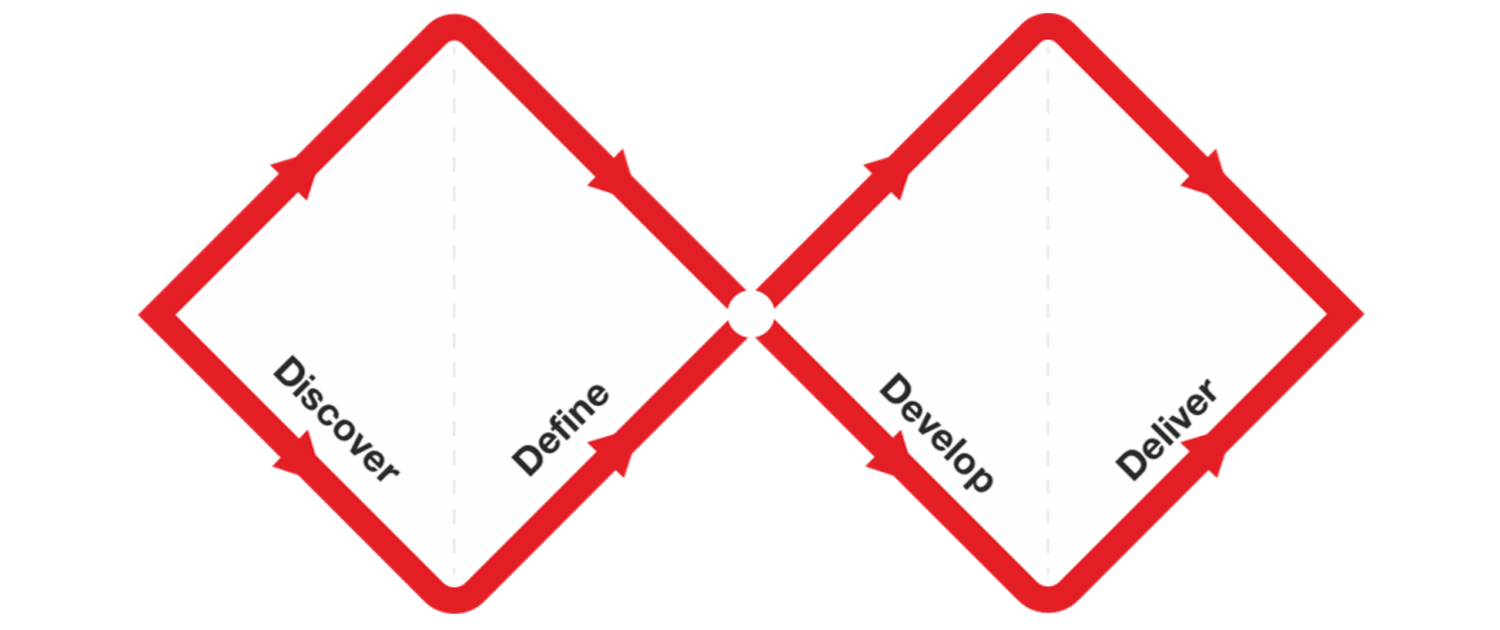The Double Diamond model: how Marketers in Component Manufacturing can identify the Buying Intent hidden within online interactions
B2B Marketers apply the Buyer’s Journey in a serious attempt to understand a Prospect’s Buying Intent. But as it turns out, the model that engineers use for solving Design and Development challenges is called the Double Diamond. Mapping the Double Diamond against the Buyers Journey gives Marketing and Sales teams an even better way to understand what a Prospect is trying to achieve.
Assessing Buying Intent is very difficult
Although Marketers can gain a lot of information about Prospects by analysing online interactions, assessing Buyer Intent continues to be difficult. Page views may indicate which subjects website visitors find most interesting. Or do they simply reflect the layers of the navigation? Time-on-Page might indicate which content delivers most value. Or then again, it may indicate the pages that are hardest to understand. Both of these yardsticks however are at their most powerful when analysed anonymously across a large volume of visitors. Even if the necessary Privacy permissions are in place, the Buying Intent of the individual visitor is seldom clear.
It’s not until the Prospect interacts with a Form that analysis of behaviour is appropriate. And even then, Buying Intent may be hidden. One of Ansaco’s clients is an international manufacturer that sells hi-tech packaging solutions in a strictly regulated industry. Their products become components within the finished goods that their Customers sell.
The website provides Lead Generation forms on each and every product webpage. Form fields capture the Contact’s details. A free-text field provides unstructured space to submit an Inquiry. A simple pull-down allows the visitor to label their Inquiry, using four categories. “Please Contact Me”, “Technical Question”, Request a Sample”, “Request a Quote”. These categories were chosen for their similarity to the stages in the Buyers Journey: from Awareness, through Consideration, to Decision.
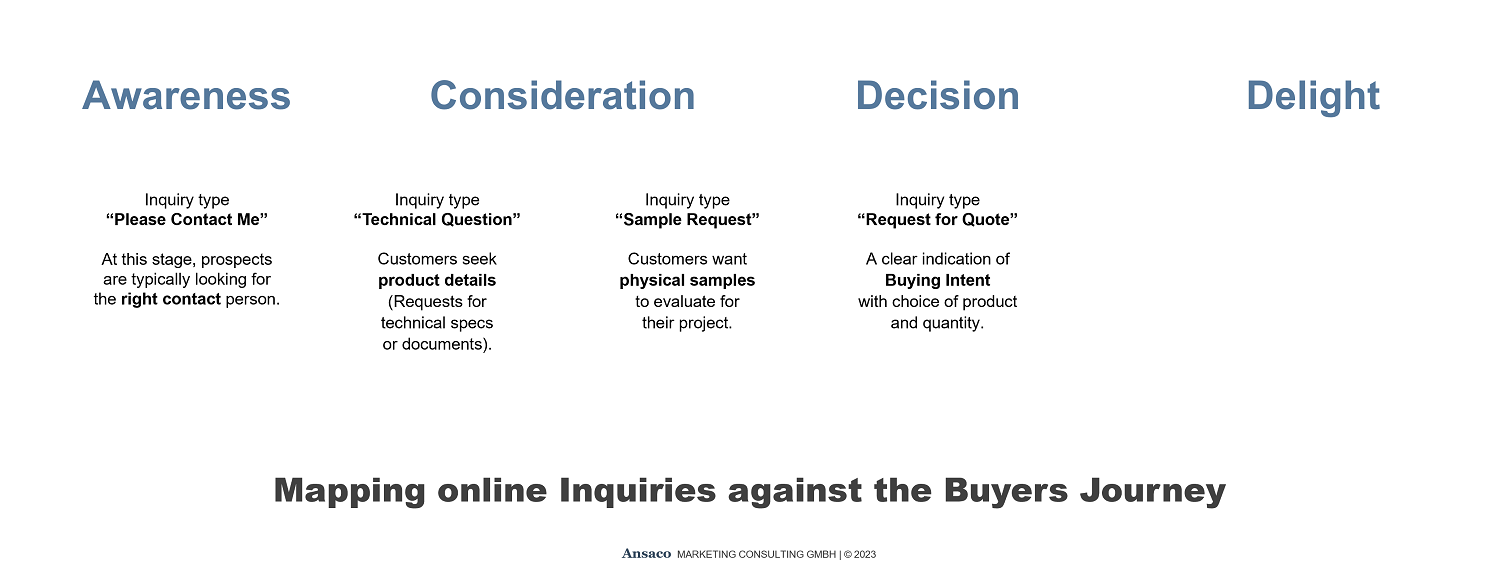
Buying Intent in Online Forms
In practice, however, mapping these categories of Inquiry to the Buyers Journey has – until recently – only met with limited success.
- The “Please Contact Me” inquiries are usually a search for the right contact person within the company – based on a combination of geography, language and product knowledge. So, yes, they map well against the Awareness stage.
- The Technical Questions are, by and large, just that. Requests for product details or for product certification documents. At first sight however, these Questions seldom contain even a hint of Buying Intent.
- Inquiries that “Request a Sample” appeared to fall into two groups. Some people expect something for free and are therefore classified as “less serious”. By contrast, those who ask directly how much Samples cost are greeted by Sales colleagues with “Aha! A serious prospect!”.
- People who submit an Inquiry and voluntarily label it as “Request a Quote” are clearly those closest to the Decision stage of the Buyers Journey. In spite of the fact that the Form explains what details are necessary to provide a quote, these Inquiries require the most effort to follow up, because solutions are complex and details often incomplete.
Even though the Lead Qualification process adopts current Best Practice, identifying Buying Intent continued to be elusive. Inquiries are matched against existing records in CRM. Filters automate, save effort and speed up Evaluation and Qualification steps, just as you’d expect. New Contact and Account records are created whenever necessary. But the link from Lead to buying intent was still vague. Were we missing something?
The Double Diamond model for defining and solving Design Problems
As it turns out, there’s another model – parallel to the Buyers Journey – that describes what the Prospect is trying to achieve. In practice, the Buyers Journey is an attempt by Sellers to empathise with their prospective customer. It is at best generic. It requires a lot of industry- and product-specific knowledge to use effectively. Only by collaborating closely with Sales can Marketers reveal the stages in the purchasing cycle, identify the Pains and Gains and learn how to describe the Value Proposition to best advantage.
The Double Diamond model describes how engineers and product managers seek and find innovative solutions to their product design problems. It’s used – in a variety of forms – by a wide range of organisations and industries. But it fits particularly well for Manufacturers who sell components that are built into their customers’ products. Best of all, it provides an accurate way for Marketers to examine and understand Buying Intent.
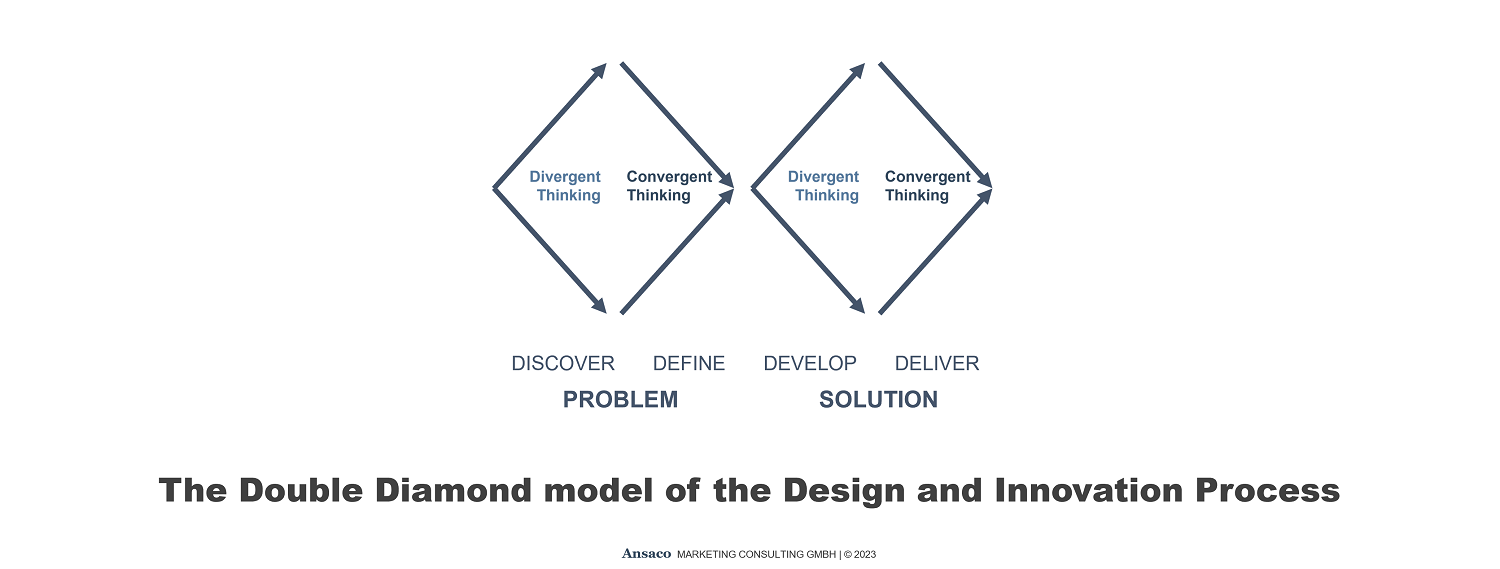
Developed by the UK Design Council in 2005, the Double Diamond model consists of two phases: “define the Problem” and “find the Solution”. Both phases are structured the same way: a period of open and exploratory Divergent Thinking is followed by focused and solution-oriented Convergent Thinking.
[Read the Design Council’s description of the Double Diamond model here.]
Define the Problem
- Discover (Divergent stage 1)
This is the initial stage where the problem space is expanded to collect as much information as possible. It could involve market research, user interviews or data analysis to gain insights and discover new opportunities. And online interaction with Forms on websites, too. - Define (Convergent stage 1)
This is where the information and insights gathered in the Discover stage are analysed and synthesized. The goal is to condense all the data collected into a clear and concise statement of a specific problem that needs to be solved.
Design the Solution
- Develop (Divergent stage 2)
The next step is to generate a wide range of possible solutions. Brainstorming, prototyping and iteration are common techniques during this stage. The aim is to foster creativity and explore different avenues for addressing the problem. - Deliver (Convergent stage 2)
This is the where the most promising solutions are tested, iterated, and refined until a final solution is reached. Once the solution is found to be effective and meets the user needs, it’s ready for implementation and delivery.
The Double Diamond model emphasizes iterative and user-centred design. It promotes the idea that solutions should not be sought immediately, but rather after a thorough understanding and definition of the problem. It underscores the value of expanding thinking before narrowing down, hence the ‘double diamond’ shape.
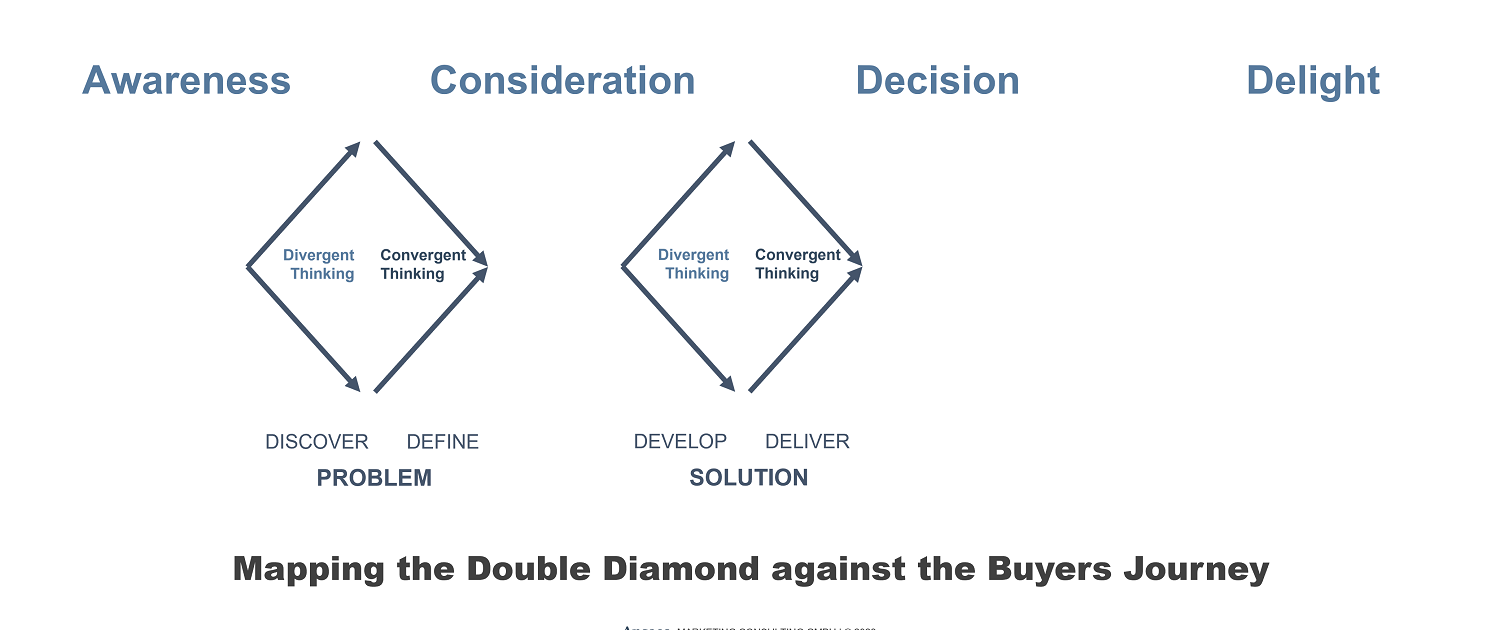
Mapping the Double Diamond against the Buyers Journey
The mapping of the two models is self-explanatory. Separate the two Problem and Solution stages of the Double Diamond model and drop them into the gaps between the first three Stages of the Buyers Journey. The Discover and Define stages describe the concrete actions the Prospect is taking as they make the journey from Awareness to Consideration.
Similarly, the Develop and Deliver stages describe what actions the Prospect takes as they make the transition from Consideration to Decision.
It gets better – the Double Diamond model provides additional insights. It indicates how the Prospect is thinking during each stage: divergent versus convergent. And it describes the Prospect’s objective at each stage: discovery about the problem; definition of the problem; development of a solution; and delivery of the solution.
Armed with these insights, we can now return to the Inquiries entered into the online forms and re-evaluate them. The Double Diamond model provides a way to distinguish different groups within the two categories “Technical Question” and “Sample Request”.
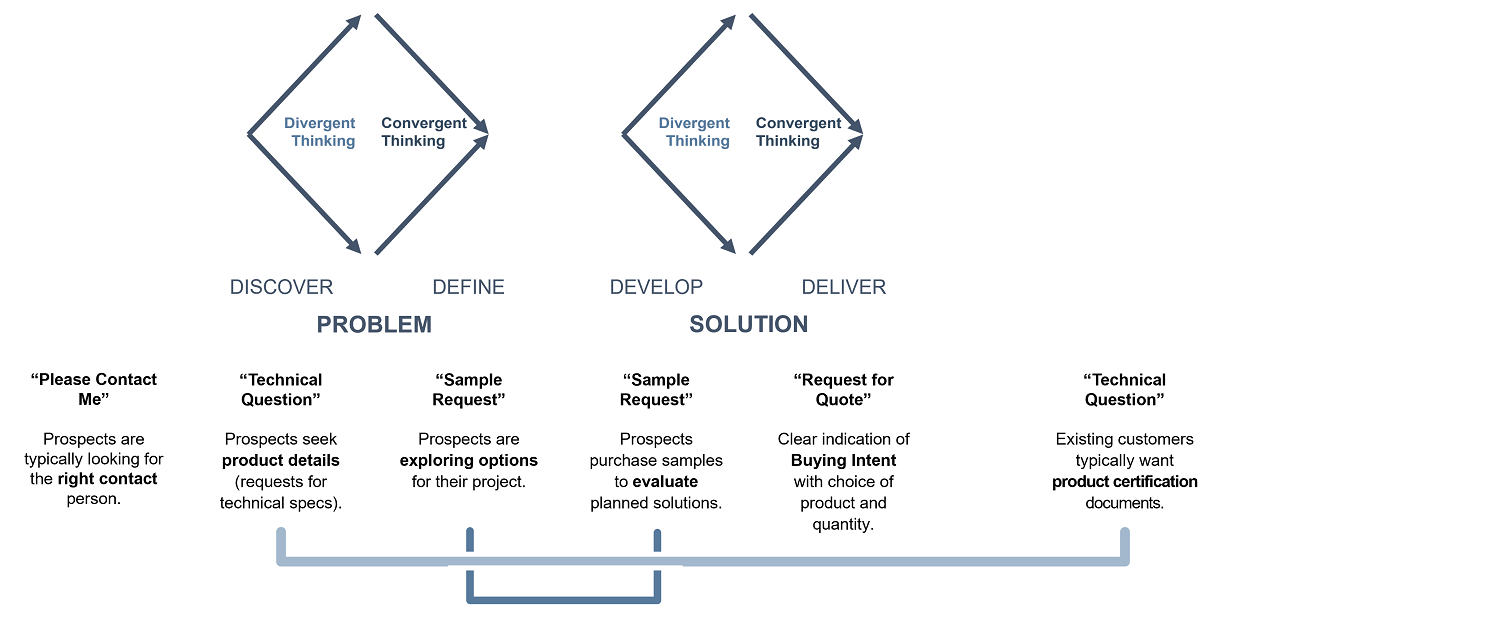
Technical Questions – before and after the Sale
Many Technical Questions, although specific about products, appear on the surface to be frustratingly vague in their buying intent. “Please provide specifications and technical drawings for Product ABC123”, for example.
The Double Diamond model explains the background, and all is clear. The prospect wants to design and develop a new product that will include a packaging solution. They are in an exploration phase and using divergent thinking. They are gathering details about as many different options as they can, with the intention of applying convergent thinking later. The buying intent is implicit in the fact that they filled out the form and asked the Technical Question. Failure to supply the information at this stage means we can’t be considered as a potential supplier later on.
A subset of the Technical Questions are requests for documentation. Closer reading of the language used reveals what’s going on. “We are already using product ABC123 and would like a copy of the certification documents …” These requests are post-sale. This is not a prospect but a customer. One who is dotting i’s and crossing t’s. Assisting the customer promptly is the best way to succeed in the Delight stage of the Buyers Journey – and earn credibility for future Repeat Sales cycles.
Different reasons for Requesting Samples
There is also a distinct split within the category labelled “Sample Requests”, with two different styles of thinking apparent.
Some indicate the convergent thinking of the Problem Definition stage. Having explored the problem from a wide variety of angles, the Prospect now tries to narrow it down. At this point they have read the brochure, seen the image, watched the video – and now they want a physical object in their hands. They want to examine it, test it and discuss it, in order to say either: “put it on the short list”; or “strike it out”.
The second type of Sample request is a very different proposition. Having narrowed the possibilities down to a shortlist, the Prospect now returns to divergent thinking again to ask “how will we use these chosen components in practice to Develop a Solution?” Answer: get a significant quantity of samples delivered, so that you can begin practical experiments. Use the chosen components to create as wide a variety of solutions as possible and test them thoroughly. The follow-on, convergent stage – Deliver the Solution – will identify the winner.
Gaining Clarity about Buying Intent
Using the Double Diamond model provides an effective way to identify the Buying Intent within Inquiries – whether stated or implicit. The Problem and Solution stages of the Model fit logically and accurately within the Buyers Journey. The model also delivers a clearer understanding of Buying Intent – the Prospects objectives at each stage, and how they address them. As a result, the fact that the Prospect submits an online Inquiry clearly implies Buying Intent.
To conclude, a few words on follow-up. All Inquiries should be evaluated and qualified promptly. If resources for follow-up or fulfilment are scarce, marketers can prioritise Inquiries that show a good fit / best fit between product capabilities and Prospect needs. Nevertheless, a policy of resolving all Inquiries as swiftly as possible is the best way to gain a reputation as Easy-to-do-Business-With over the long-term.

